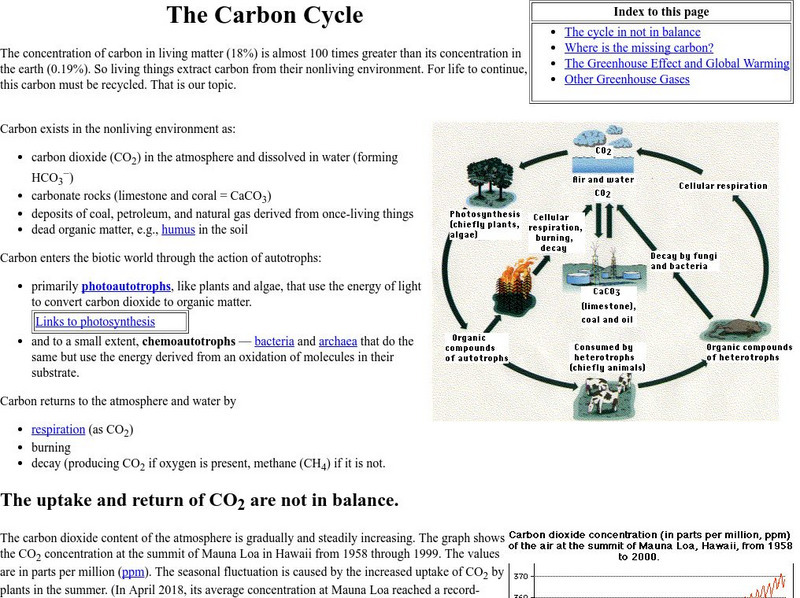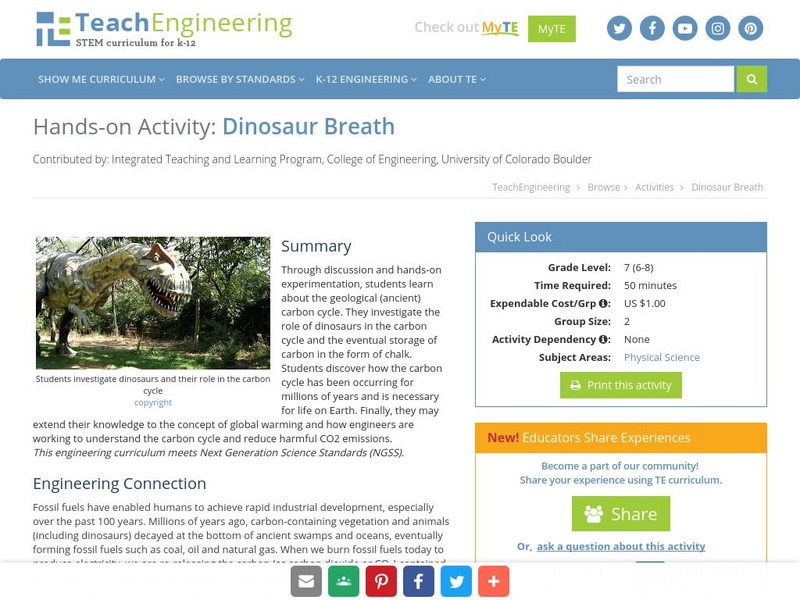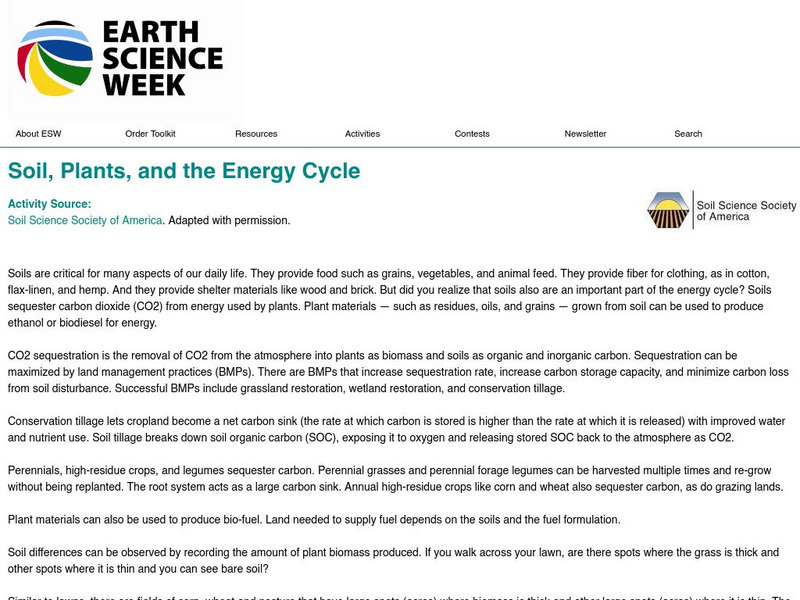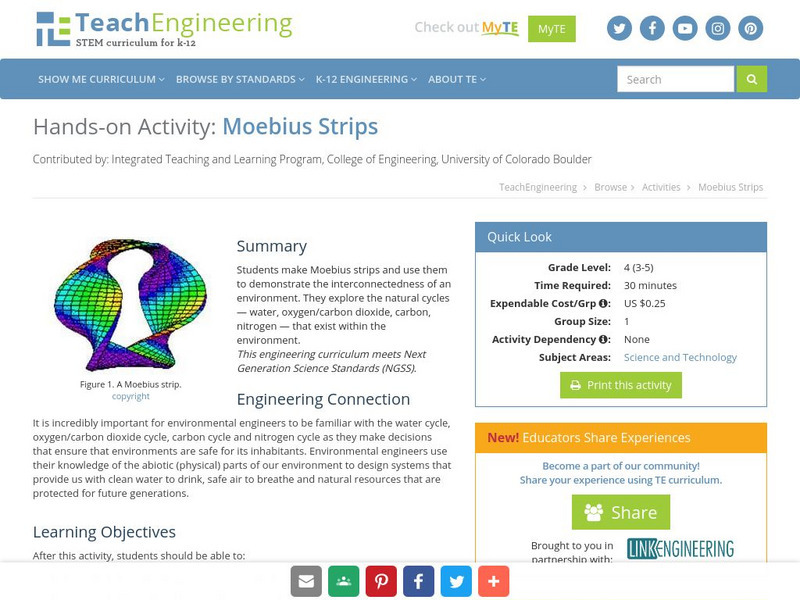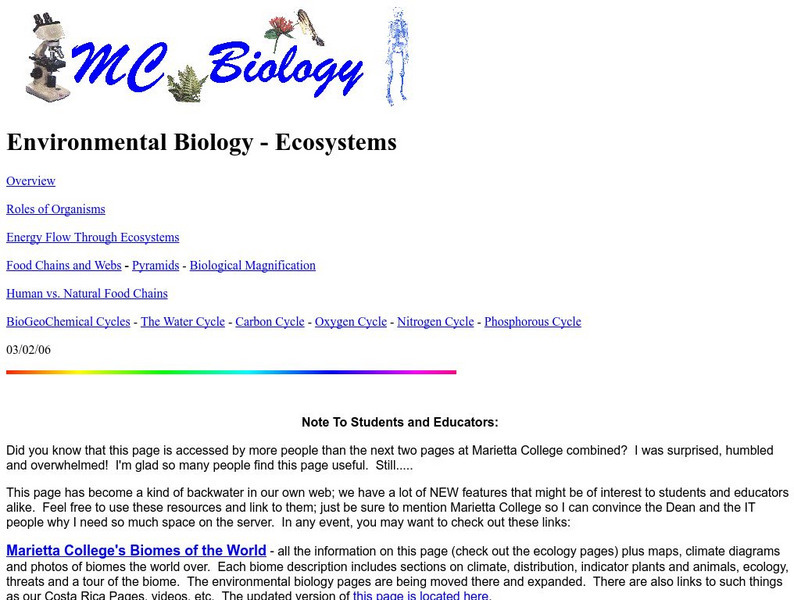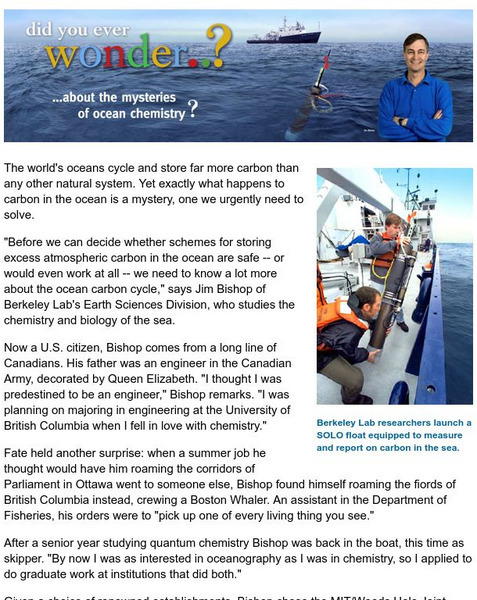University Corporation for Atmospheric Research
Ucar: The Carbon Cycle
A comprehensive introduction to the carbon cycle. The cycle of atoms between living and non-living things is known as a biogeochemical cycle. The most common of these are the carbon and nitrogen cycles.
Biology Pages
Kimball's Biology Pages: The Carbon Cycle
Useful introduction to the carbon cycle with a diagram and a discussion of the effects of carbon dioxide on the greenhouse effect and global warming.
Mocomi & Anibrain Digital Technologies
Mocomi: Carbon Cycle
The carbon cycle is one of the most important cycles. It is the biogeochemical cycle by which carbon is exchanged among the biosphere, pedosphere, geosphere, hydrosphere, and atmosphere of the Earth. This cycle is important because it...
CK-12 Foundation
Ck 12: Life Science: 12.22 Carbon Cycle
Understand the role that the carbon cycle plays in the ecosystem.
BiologyWise
Biology Wise: A Brief Guide to the Steps of the Carbon Cycle
Outlines the steps for the movement of carbon along the carbon cycle through photosynthesis, food chains, being dissolved into the ocean, the decomposition of organisms, fossil fuel formation, industrial use of fossil fuels, carbon...
TeachEngineering
Teach Engineering: Dinosaur Breath
Through discussion and hands-on experimentation, students learn about the geological (ancient) carbon cycle. They investigate the role of dinosaurs in the carbon cycle and the eventual storage of carbon in the form of chalk. Students...
Nature Conservancy
The Nature Conservancy: Reforestation: Impact on Climate
Deforestation is clearing Earth's forests on a massive scale. In this lesson, students learn the value of large-scale forest landscapes and their role in the carbon cycle.
American Geosciences Institute
American Geosciences Institute: Earth Science Week: Soil, Plants, and the Energy Cycle
Students explore what kind and how much bio-mass can be produced in an area around your city or town. They figure how many gallons of fuel can be expected from one acre of crop land, and how much carbon can be sequestered in the local area.
TeachEngineering
Teach Engineering: Moebius Strips
In this activity, students make Moebius strips and use them to demonstrate the interconnectedness of an environment. They will explore the natural cycles (water, oxygen/carbon dioxide, carbon, nitrogen) within the environment.
Other
Marietta College: Ecosystems
Complete illustrated discussion of energy flow within ecosystems, including discussions of trophic levels, ecological pyramids, food chains and webs, biological magnification, and cycles.
Ohio State University
Ohio State University: Concepts of Plant Ecology
An advanced discussion of plant interactions and relationships. Energy flow, nutrient cycling and succession are discussed. Try the quiz to check your understanding.
CPALMS
Florida State University Cpalms: Florida Students: Photosynthesis
Be able to explain how sugar is produced by capturing carbon in the atmosphere by completing this tutorial. Also learn the major molecules and their roles in photosynthesis.
Other
The Incalculable Importance of Plankton
Plankton is a passively swimming plant life in a body of water known as the ocean. The Plankton that live in our ocean have one of the most important roles in the our Carbon Ecosystem. The importance of Plankton in our Ecosystem is...
Estrella Mountain Community College
On Line Biology Book: Photosynthesis
A comprehensive delve into the many facets of photosynthesis. Text is supplemented with effective pictures and graphs. Review questions can be found at the end of the site.
King's Centre for Visualization in Science
Explaining Climate Change: Lesson 7: Climate Feedback Loops
This is the seventh lesson in a series of learning modules on the topic of climate change. In this lesson, you will learn how several important feedback loops help drive and regulate earth's unique climate system and affect climate...
Lawrence Berkeley National Laboratory
Berkeley Lab: Did You Ever Wonder? About the Mysteries of Ocean Chemistry?
Students investigate ocean chemistry. The article discusses Jim Bishop, ocean cycle, the biology of the sea, and carbon in the sea. The resource consists of pictures, quotes, and links to additional resources.
OpenSciEd
Open Sci Ed: Net Logo: Chloroplasts and Food Model
The simulation shows the relationship between the inputs and outputs in the chloroplasts of plant, that can help explain how they convert water and carbon dioxide to glucose and water with the help of energy absorbed from light.
University of Illinois
University of Illinois: Photosynthesis and the Web
Page describes Photosynthesis in great detail. Provides an extensive amount of links on all different aspects of photosynthesis. Very thourough.
Ohio State University
Ohio State University: Plant Transpiration & Translocation
This is a good explanation of plant water balance issues and carbon fixing cycles. Transpiration processes are explained well with links to additional information.
University of Illinois
University of Illinois Extension: Energy and Ecosystems Use Some Lose Some
Life on Earth is possible because energy flows one way through ecosystems, while matter cycles endlessly. Water and elements, such as carbon, nitrogen, phosphorous, and sulfur are examples of matter that cycles through ecosystems.
NASA
Climate Kids: Greenhouse Effect
Fun website for kids to learn about earth science. Students read about greenhouse gasses and the effect on the environment.
Other popular searches
- Carbon Cycle Diagram
- Carbon Cycle Powerpoint
- Carbon Cycle Activities
- Nitrogen and Carbon Cycle
- Carbon Cycle Lesson Plans
- Carbon Cycle Game
- The Carbon Cycle
- Carbon Cycle Lab
- Carbon Cycle Worksheet
- Ecology Carbon Cycle
- Oxygen Carbon Dioxide Cycle
- Carbon Cycle Diagram Label

